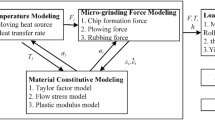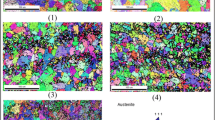Abstract
In the micro-grinding process, owing to the size effect, the effects of material microstructure on the grinding force are more significant through the variation of material flow stress. Currently, the variation of material flow stress resulting from the change of crystallographic orientation during the micro-grinding has not been well examined. In this paper, a new predictive model for the variation of flow stress due to the process-induced change of crystallographic orientation is developed, which is based on the Taylor factor as determined by calculating the activated slip systems, thus quantifying the way crystallographic orientation affects both the number and the style of activated slip systems. Moreover, the predicted force is compared with previous reported experimental data on monocrystalline copper. As a result, the following findings are obtained from the comparison between the predicted result and the experimental data: (1) The predicted microgrinding force agrees well in trend with the experimental force, suggesting that the approach for predicting the grinding force based on the Taylor factor is feasible; (2) In the microgrinding of single-crystal materials, the feed rate direction relative to the crystallographic orientation has great effects on the flow stress and hence on the grinding force.
Similar content being viewed by others
References
Chae J, Park SS, Freiheit T (2006) Investigation of micro-cutting operations. Int J Mach Tools Manuf 46(3–4):313–332
Chen MJ, Ni HB, Wang ZJ, Jiang Y (2012) Research on the modeling of burr formation process in micro-ball end milling operation on Ti–6Al–4V. Int J Adv Manuf Technol 62(9–12):901–912
Zhang T, Liu ZQ, Xu CH (2013) Influence of size effect on burr formation in micro grinding. Int J Adv Manuf Technol 68(9–12):1911–1917
Zhan ZB, Li L, He N, Shrestha R (2014) An experimental study on grinding parameters for manufacturing PCD micro milling tool. Int J Adv Manuf Technol 73(9–12):1799–1806
Park HW (2008) Development of micro-grinding mechanics and machine tools, Dissertation, Georgia Institute of Technology
Malkin S (1989) Grinding technology: theory and applications of machining with abrasives. Ellis Howard Ltd, Prentice Hall
Li L, Fu J (1980) A study of grinding force mathematical model. Procedia CIRP 29:245–259
Meng P (2016) Microstructure and performance of monolayer brazed grinding wheel with polycrystalline diamond grains. Int J Adv Manuf Technol 83(1–4):441–447
Li HN, Yu TB, Zhu LD, Wang WS (2015) Modeling and simulation of grinding wheel by discrete element method and experimental validation. Int J Adv Manuf Technol 81(9–12):1921–1938
Li XK, Wolf S, Zhi G, Rong YM (2014) The modelling and experimental verification of the grinding wheel topographical properties based on the ‘through-the-process’ method. Int J Adv Manuf Technol 70(1–4):649–659
Wu X, Li L, He N, Zhao M, Zhan ZB (2015) Investigation on the influence of material microstructure on grinding force and bur formation in the micro grinding of copper. Int J Adv Manuf Technol 79(1–4):321–327
Patten J, Gao W, Yasuto K (2005) Ductile regime nanomachining of single-crystal silicon carbide. ASME J Manuf Sci Eng 127(3):522–532
Sharif UM, Seah KHW, Li XP, Rahman M, Liu K (2004) Effect of crystallographic orientation on wear of diamond tools for nano-scale ductile cutting of silicon. Wear 257(7–8):751–759
Lee WB, To S, Cheung CF (2000) Effect of crystallographic orientation in diamond turning of copper single crystals. Scr Mater 42(10):937–945
Zhou M, Ngoi BKA, Zhong ZW, Wang XJ (2001) The effect of material microstructure on micro-grinding processes. Mater Manuf Process 16(6):815–828
Hughes DA, Hansen N (2000) Microstructure and strength of nickel at large strains. Acta Mater 48(11):2985–3004
Hall EO (1951) The deformation and ageing of mild steel: III discussion of results. Proc Phys Soc B 64:747–753
Park HW, Liang SY (2008) Force modeling of micro-grinding incorporating crystallographic effects. Int J Mach Tools Manuf 48(15):1658–1667
Venkatachalam S, Fergani O, Li XP, Guo YJ, Chiang KN, Liang SY (2015) Microstructure effect on cutting force and flow stress in ultra-precision machining of polycrystalline brittle material. J Manuf Sci Eng 137(2):1–9
Venkatachalam S, Li XP, Fergani O, Guo YJ, Liang SY, Bryan MM (2013) Crystallographic effects on microscale machining of polycrystalline brittle materials. J Micro Nano-Manuf 1(4):1–11
Demir E (2008) A Taylor-based model for micro-machining of single crystal fcc materials including frictional effects-application to micro-milling process. Int J Mach Tools Manuf 48(14):1592–1598
Park HW, Liang SY (2009) Force modeling of microscale grinding process incorporating thermal effects. Int J Adv Manuf Technol 44(5–6):476–486
Merchant ME (1945) Mechanics of the metal cutting process. II plasticity conditions in orthogonal cutting J Appl Physics 16(6):317–324
Abed FH, Voyiadjis GZ (2005) Plastic deformation modeling of AL-6XN stainless steel at low and high strain rates and temperatures using a combination of BCC and FCC mechanisms of metals. Mech Mater 37(8):1618–1639
Johnson GR, Cook WH (1985) A constitutive model and data for metals subject to large strain, high strain rates and high temperatures. Proceeding of the Seventh International Symposium on Ballistics, Hague, pp. 541–547
Oxley PLB (1989) The mechanics of machining: an analytical approach to assessing machinability. Ellis Horwood Limited, Chichester
Lee WB, Zhou M (1993) A theoretical-analysis of the effect of crystallographic orientation on chip formation in micromachining. Int J Mach Tools Manuf 33(3):439–447
Schimdt E, Boas W (1950) Plasticity of crystal. Springer and Hughes, Berlin and London
Ashcroft NW, Mermin ND (1976) The drude theory of metals. Solid State Physics, Harcourt, New York
Lin C (1999) China metallurgical encyclopedia, metal and plastic processing. metallurgical industry press, Beijing
Frutschy KJ, Clifton RJ (1998) High-temperature pressure-shear plate impact experiments on OFHC copper. J Mech Phys Solids 46(10):1723–1743
Author information
Authors and Affiliations
Corresponding author
Rights and permissions
About this article
Cite this article
Zhao, M., Ji, X., Li, B. et al. Investigation on the influence of material crystallographic orientation on grinding force in the micro-grinding of single-crystal copper with single grit. Int J Adv Manuf Technol 90, 3347–3355 (2017). https://doi.org/10.1007/s00170-016-9605-1
Received:
Accepted:
Published:
Issue Date:
DOI: https://doi.org/10.1007/s00170-016-9605-1




